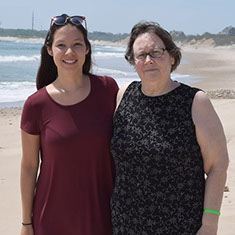What if you were suddenly diagnosed with a potentially fatal disease just when your life, work and marriage were on track and your plans to start a family where underway?
This is what happened to Sue R. Levy. In 2008, at age 37, she was diagnosed with Pulmonary Lymphangioleiomyomatosis, otherwise known as LAM. LAM is a rare, chronic, progressive lung disease in which the lungs fill up with cysts. The result is gradual destruction of the normal lung architecture, compromised breathing, and in many cases, eventual lung transplant.
Fueled by estrogen, LAM primarily affects women in their childbearing years. With only 1300 documented cases in North America, LAM is poorly understood and at present no therapies of proven benefit exist.
Prior to diagnosis, Sue would have defined herself as happy and healthy. She had a successful career as a marketing executive, she was happily married, and she and her husband had decided to start a family. Though they struggled with infertility, undergoing six unsuccessful rounds of IVF, Sue still felt that this would work out eventually, and that perseverance would pay off.
In her words, “ My whole life I thought the way the world worked is that if you were a good person and you worked hard you could avoid bad things”. LAM changed everything.
Suddenly, Sue was forced to redefine herself as someone with a chronic disease and confront her own mortality. In addition, she had to let go of some of her dreams, first and foremost her desire for pregnancy, as the high levels of estrogen associated with carrying a child would accelerate her lung destruction. Initially, she was angry. What had she done to deserve this? Over time, though, her perspective shifted. She came to accept her diagnosis and she let go of her preconceived notions of how her life “should” unfold.
Today, Sue would say that living with a chronic disease and an uncertain future, while obviously challenging at times, has improved her life dramatically. Her disease has helped her to get in touch with what she really cares about, and has set her life on a new course. With the goal of educating and healing herself, she went to school to study nutrition and became a natural foods chef. In 2011, inspired by how great she felt after making some lifestyle changes, she quit her marketing job and started Savory Living, a nutrition and healthy eating company that provides online nutrition and healthy eating classes and cooking classes, helping others to “eat well and feel better now.”
In addition, Sue and her husband now have two young daughters, conceived using egg donors and a gestational carrier. While the journey was difficult at times, the end result is a beautiful family. Sue feels happier and healthier than she ever has.
In an upcoming follow up piece, Sue will share more about her struggle with infertility and her journey to motherhood.
Originally published on WBUR Commonhealth Blog on April 4th, 2014.
Pulmonary lymphangioleiomyomatosis resources:
1) To learn more about LAM, visit http://www.thelamfoundation.org/what-is-lam
2) To listen to patient stories and find more information about LAM, visit http://www.lam.org.nz/videos.htm and http://lamaction.org/for-patients-their-families/patient-support/
3) To locate a patient support group:
301-592-8573 is the number for the National Heart, Lung, and Blood Institute Health Information Center that can provide information about patient support groups.
1-877-644-5864, extension 3 is the number for the National Heart, Lung, and Blood Institute Health and Information Pulmonary Vascular Medicine Branch, which can also provide this information.




















